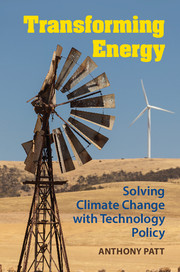Book contents
- Frontmatter
- Dedication
- Contents
- Foreword
- Acknowledgments
- PART 1 SETTING THE STAGE
- 1 From optimism to pessimism and back again
- 2 The natural and social science of climate change
- 3 The solution space and its distractions
- PART 2 FAILED STRATEGIES TO REDUCE EMISSIONS
- PART 3 SUCCESSFUL STRATEGIES TO MOVE US AWAY FROM FOSSIL FUELS
- Notes
- Index
3 - The solution space and its distractions
from PART 1 - SETTING THE STAGE
Published online by Cambridge University Press: 05 July 2015
- Frontmatter
- Dedication
- Contents
- Foreword
- Acknowledgments
- PART 1 SETTING THE STAGE
- 1 From optimism to pessimism and back again
- 2 The natural and social science of climate change
- 3 The solution space and its distractions
- PART 2 FAILED STRATEGIES TO REDUCE EMISSIONS
- PART 3 SUCCESSFUL STRATEGIES TO MOVE US AWAY FROM FOSSIL FUELS
- Notes
- Index
Summary
A 2°C target makes sense, not because it is necessarily grounded in solid science or economics, but because it represents a good compromise of competing interests. Moreover, the actions needed to achieve the 2° C target are ones that would be needed for even lower targets and would be actions that would make sense even if the target were somewhat higher. The important recognition underlying the 2°C target is that the world needs to eliminate all carbon dioxide (CO2) emissions as quickly as is practical and feasible. Indeed, it is undertaking these actions that then becomes the immediate problem for policy makers: primarily the replacing of the fossil fuel-based energy system with something else, but also doing something about forest degradation and the other industrial sources of greenhouse gases (GHGs). But before turning to how they can do these things – the transformation of the energy system in particular – it is worth clearing the air of some distractions. The distractions involve protecting ourselves from what we have wrought and include both adapting to a changing climate and coaxing the planet into staying cooler despite the CO2 that we continue to emit. They are not distractions because they are unimportant; indeed, they may prove to be crucially important for protecting human lives and vast ecosystems. But they can only work as long-term strategies if they complement, rather than substitute for, the core challenge of reducing GHG emissions and CO2 emissions in particular. They are distractions if they cause us to forget about this imperative.
Adaptation
Humanity has always been protecting itself from nature one way or another and constantly doing a better and better job of it as the technologies at people's disposal have improved and expanded. The first house I owned, a Vermont farmhouse built in the early 1800s, had window frames that kept out the winter as good as wood pressed against wood could do. My second house, an Austrian one built a century later, had windows that kept out the wind better, with a seal of rubber against wood.
Information
- Type
- Chapter
- Information
- Transforming EnergySolving Climate Change with Technology Policy, pp. 39 - 52Publisher: Cambridge University PressPrint publication year: 2015
